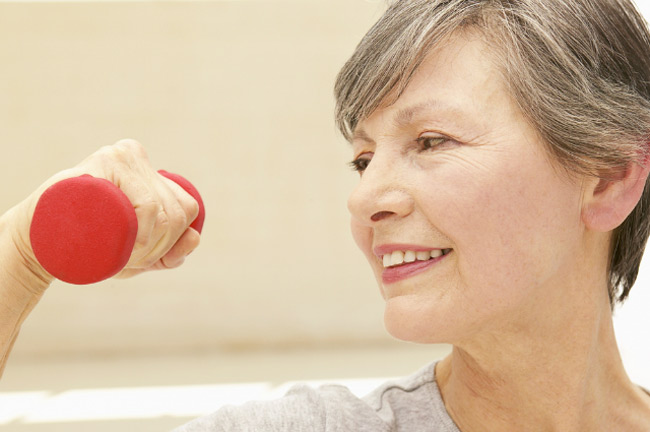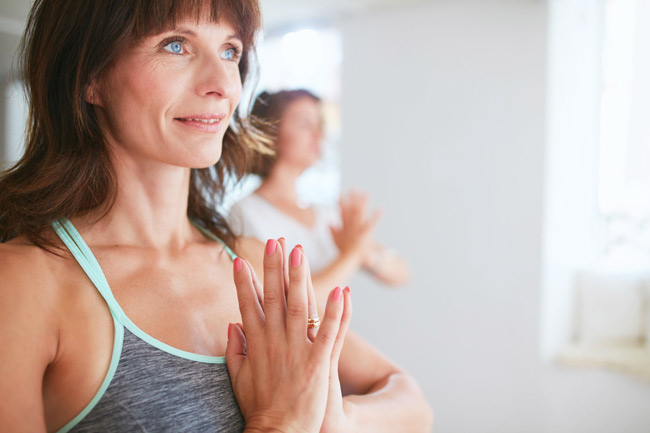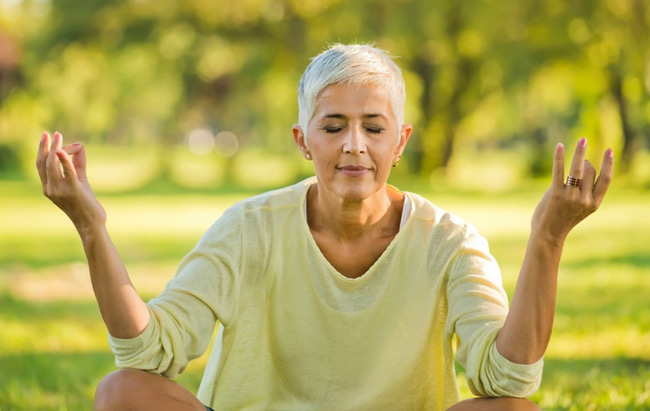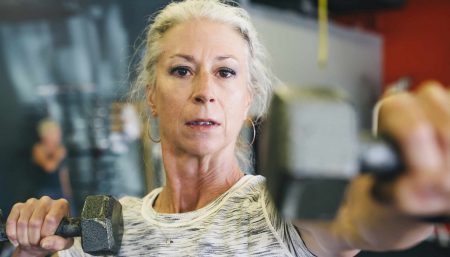Menopause brings with it a wide range of changes to a woman’s body. Without doubt, exercise is the menopausal woman’s best friend in a way that it allows to control your body and emotions by using your internal resources.

Each time that you take exercise, your adrenal glands are stimulated to convert the male hormone androstenedione into oestrogen. A minimum of four 30-minute exercise sessions each week will help to keep your body producing a little oestrogen.
As you become older, your cardio-respiratory fitness, your strength and your flexibility all begin to decline. For people who remain active, however these things decrease at a lower rate (an average of five percent per decade after the age of about 20, as opposed to nine percent per decade).
Long-term exercise also means that you will have stronger bones and a lower risk of osteoporosis than non-exercisers. Although every woman is different, most of us lose 25 – 35 percent of our bone mass by the time we reach the age of 65. Bone loss begins around the age of 35, proceeds slowly up to the menopause, and then accelerates during the five to seven years after the menopause, when oestrogen levels are low.
Regular exercise may also have a significant effect on our mental agility by increasing the amount of oxygen supplied to brain. In a comparison between sedentary older women and older women who exercised regularly, after four months the latter group processed information faster in tests. Exercise can also prevent our reaction times from slowing down.

WHICH TYPE OF EXERCISE?
The type of exercise that you take obviously depends largely on resources, how much time you have to devote to exercise and your own personal preference. Nowadays there is a wide range of opportunities available, and not only in sports centers and fitness classes. If you need or prefer to exercise in your own home, there are many excellent exercise videos and other publications on the market that will show you the best ways to preserve your muscle strength and tone.
Sedentary women may also suffer more from chronic back pain, stiffness, insomnia, and irregularity. They often have poor circulation,weak muscles, shortness of breath, and loss of bone mass. Depression can also be a problem. Women who regularly walk, jog,swim, bike, dance, or perform some other aerobic activity can more easily circumvent these problems and also achieve higher HDLcholesterol levels. Studies show that women performing aerobic activity or muscle-strength training reduced mortality from cardio vascular disease and cancer.
You may prefer sport such as tennis, badminton or squash, all of which offer the added attraction of meeting and socializing with people. Likewise, joining an aerobics or exercise class can provide a social aspect that may encourage you to to exercise regularly. Less rigorous and more traditional forms of exercise, such as walking and swimming, offer viable alternatives, and will keep the body fit and supple. Unfortunately, you cannot “store” the benefits of exercise; it must be ongoing to confer its many benefits .
THINKING POSITIVELY :
The first step towards taking charge of your life and managing your menopause is to take charge of your body. You need to play an active role with all of your medical and health providers. Be aware of all your options and exercise them in order to eliminate as many health problems as you can. The strategy you choose to deal with any menopausal symptoms you may suffer from is up to you. You could decide on try self-help measures, for instance, or complementary medicine such as herbal remedies or homeopathy. Alternatively, you may feel that your symptoms warrant conventional medical help.
To achieve these goals, you need to have a firm sense of your own self-worth and optimism about the future, and you must be prepared to make an effort. As soon as you start to take control of your menopausal symptoms, your health and sense of well-being will benefit greatly.
The second step towards taking charge of your life and managing your menopause is to take charge of your mind. As with your body, you need to be positive in your attitude and prepared to make a real effort to get what you want from both your family and friends, and from medical and other professionals with whom you come into contact. Try to keep in mind positive statements such as “Femininity does not have to equal fertility”, and remember that the menopause is not the beginning of the end; it’s the beginning of the rest of your life.
While health and vigour during the menopausal years depend a great deal on following a good diet and taking plenty of regular exercise, these are by no means the only resources you have to draw upon. Rest, relaxation and a variety of leisure activities will help you keep active and mentally alert. You also need self-affirming thoughts to maintain your self-confidence and prevent self-criticism. Never allow yourself to think that you are unattractive, lack lustre or out-of touch.

STAYING MENTALLY FIT :
Without stimulation, our brains will slow down and become feeble . We can learn a lot by observing the qualities of people whose mental and emotional resilience we admire. The following qualities come from emotional openness, flexibility and self-reliance.
Independence and recognition of other’s independence, privacy and peace.
- Lack of self-pity, so that when a problem arises it is looked at objectively.
- The attitude that nothing is hopeless and problems are there to be solved.
- A sense of inner security rather than security gained from controlling others.
- Taking responsibility for our own mistakes.
- A few close and loving relationships rather than many superficial ones.
- A sense of realism about the goals we set ourselves.
- Being in touch with our emotions and feeling free to express them.
MEMORY MAINTENANCE :
You can improve your memory by following the simple measures outlined below.
- When you read a book or magazine article, summarize the plot or the points made in it to a friend.
- When you’re going shopping, try to collect as many items as possible without referring to your shopping list.
- If you want to remember several things, do it with a mnemonic – a series of letters forming a word that will act as a memory aid. For example, you can abbreviate tasks such as ironing, making a phone call and typing a letter into the single word, PIT (Phone / Iron / Type).
- If you walk into a room and forget why you’re there, go back to where you came from and don’t leave until you have remembered.
- If you have lost something, track it down. Write down the last six things you did prior to losing it and where you were for each activity. Draw a grid with what you were doing along one side and where you were along the bottom. The item you’ve lost lies in one of those squares; check out each one until you come across it.

HOW REGULAR EXERCISE HELPS
Taking regular exercise has many physical and mental benefits. It gives you:
- A reduced risk of heart disease.
- A lower chance of developing diabetes mellitus.
- Maintenance of muscle tone and strength.
- Higher levels of the healthy type of cholesterol in the blood.
- Healthier bones and less chance of developing osteoporosis later in life.
- A more efficient immune system to fight disease.
- Reduced body fat.
- Better appetite control.
- Increased mental agility.
- Fewer headaches.
- Improved sleep quality.
- Flexible joints.
DEEP MUSCLE RELAXATION :
Follow the steps below to relax your body.
- Find a peaceful place. Lie on your back, or sit in a comfortable chair, and close your eyes.
- Tense your right hand (or left, if your are left-handed), then let it go loose. Imagine it feels heavy and warm. Repeat with your right forearm, upper arm and shoulder, then move on to the right foot, lower leg, upper leg. Now do exactly the same thing with the left side of your body. By the time you have finished, your hands, arms and legs should feel heavy, relaxed and warm. Allow a few seconds for these feelings to develop and to get used to the sensation.
- Now relax the muscles around your hips and waist. Let the relaxation flow up the abdomen into the chest. You will find that your breathing starts to slow down.
- Let the relaxation go into your shoulders, facial and jaw muscles. Pay special attention to the muscles around your eyes and forehead – tense them, then let the frown melt away. Finish imagining that your forehead feels cool and smooth

SEEKING DEEP MENTAL RELAXATION :
Follow the steps below to relax your mind.
- Allow thoughts to associate freely in your head.
- Stop any recurring negative thoughts by saying “no” to them under your breath, and repeating a firm “no” until they go away.
- With your eyes closed, imagine a tranquil scene such as a calm blue sea. Whatever you imagine, try to see the colour blue, because this is very therapeutic.
- Concentrate on your breathing – and make sure it is deep, slow and natural. Follow each breath as you inhale and exhale.
- By now, you should feel calm and rested. You may find it helpful to repeat a soothing mantra, such as “love”, “peace” or “calm”.
- Remind yourself to keep the muscles of your face, eyes and forehead relaxed, and imagine that your forehead is cool and smooth.
Related Links
- Exercise for Building Better Bones
- Health and Fitness Needs for women at 40
- Full-body workout: BODY, MIND AND SOUL
- Top 10 Exercise Options at 40
- Top 10 Anti-ageing Nutrition Habits
Disclaimer
The Content is not intended to be a substitute for professional medical advice, diagnosis, or treatment. Always seek the advice of your physician or other qualified health provider with any questions you may have regarding a medical condition.



